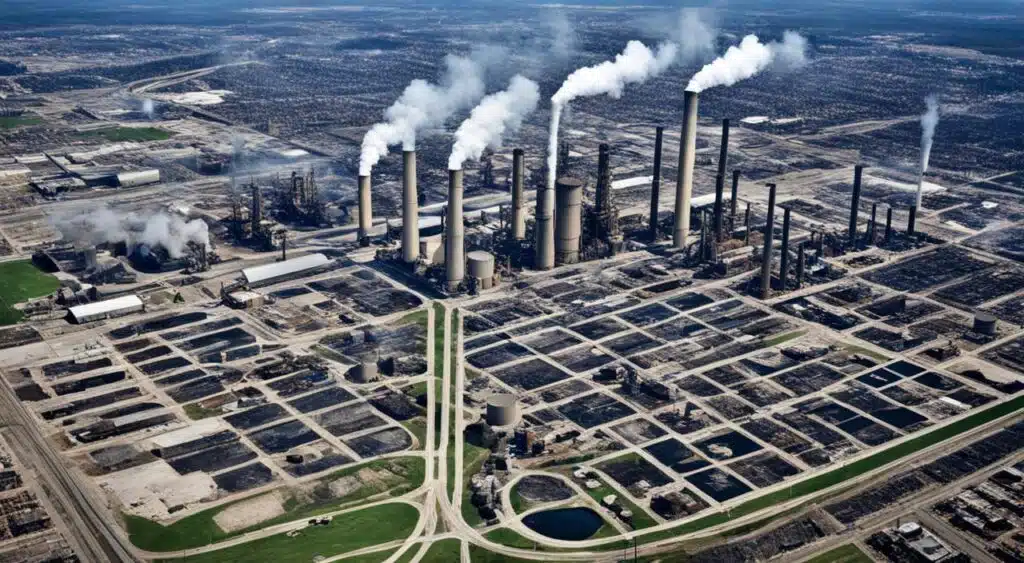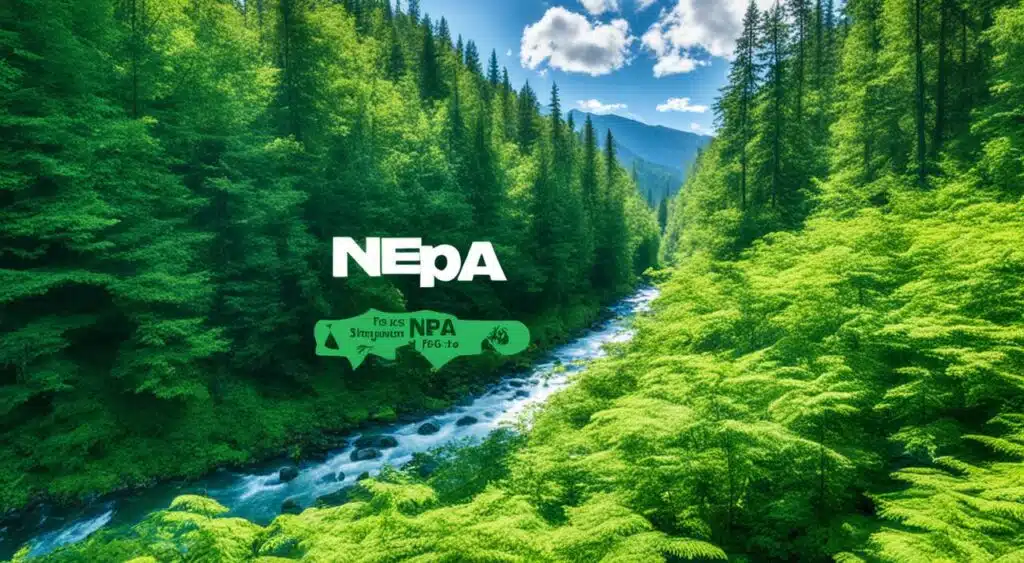The United States has made big steps in environmental law over the years. These laws help keep our air and water clean, manage hazardous waste, save endangered animals, and fight environmental racism. Important laws include the Clean Air Act, Clean Water Act, Comprehensive Environmental Response, Compensation, and Liability Act (CERCLA), Endangered Species Act, and National Environmental Policy Act.
Key Takeaways
- The U.S. has passed many laws to protect the environment and tackle environmental issues.
- Key acts are the Clean Air Act, Clean Water Act, CERCLA, Endangered Species Act, and National Environmental Policy Act.
- These laws cover air and water quality, hazardous waste, endangered species, and environmental racism.
- The Environmental Protection Agency (EPA) leads in enforcing these environmental laws.
- Knowing these major environmental law acts is key to solving environmental problems and promoting sustainability.
Also Read : What Are Employee Rights Under Employment Law?
Introduction to Environmental Law
The history of environmental law in the U.S. goes back to the 1970s. During this time, laws like the Clean Air Act and Clean Water Act were passed. These laws aimed to control pollution in air, water, and toxic substances. The Environmental Protection Agency (EPA) was created in 1970. It plays a key role in monitoring the environment, doing research, and working with local governments on pollution.
History and Background
Before the 1970s, the U.S. government didn’t focus much on protecting the environment. But as people became more aware of air and water pollution, and the need to save natural resources, things changed. This led to the creation of federal environmental laws and the EPA. These laws help protect people’s health, nature, and the environment.
Also Read : What Is The Purpose Of Tax Law?
Importance of Environmental Regulations
- Protect public health by regulating air and water quality, hazardous waste disposal, and other environmental factors
- Conserve natural resources and preserve fragile ecosystems
- Promote sustainable development and mitigate the impact of human activities on the environment
- Provide a legal framework for enforcing environmental standards and holding polluters accountable
The National Environmental Policy Act (NEPA) of 1970 was key. It created the Council on Environmental Quality and set the stage for today’s environmental regulations in the U.S.
“Environmental regulations are essential for protecting the delicate balance of our natural world and ensuring a sustainable future for generations to come.”
Also Read : What Are Key Principles Of Corporate Law?
The Clean Air Act (CAA)
The Clean Air Act (CAA) of 1970 is a key federal law. It controls air pollution from moving and fixed sources to make the air cleaner in the United States. The main goals are to keep the air clean, protect health, and improve quality of life.
Objectives and Scope
The clean air act sets national ambient air quality standards (NAAQS) for six pollutants: dust, ground-level ozone, carbon monoxide, sulfur oxides, nitrogen oxides, and lead. These standards help decide what air pollution is safe for people. States must make plans to meet these standards to protect everyone’s health.
Enforcement by the EPA
The Environmental Protection Agency (EPA) makes sure the clean air act is followed. They set and check the national ambient air quality standards. They also watch over state plans to make sure they work. Thanks to the EPA, the air has gotten much cleaner, but some communities still face big pollution problems.
| Key Provisions of the Clean Air Act | Achievements |
|---|---|
|
|
Even though the clean air act has made a big difference, some groups still face more pollution. These groups are often minorities and those with lower incomes. Fixing this environmental injustice is a key goal for the EPA and future updates to the clean air act.
Also Read : What Is The Purpose Of International Law?
The Clean Water Act (CWA)
The Clean Water Act was passed in 1972. It’s a key environmental law in the U.S. This law sets up programs to control pollution, creates national water quality standards, and bans pollutants in water without a permit.
The main goal is to keep the nation’s waters safe and healthy. It sets high standards for water quality. It also controls industrial wastewater and makes sure sewage is treated before it goes into waterways.
This law has greatly improved American water quality. But, many communities, especially those with lots of low-income and minority people, still struggle with water pollution. This is due to weak enforcement and implementation.
Key Provisions of the Clean Water Act
- Establishes the National Pollutant Discharge Elimination System (NPDES) to regulate the discharge of pollutants into navigable waters
- Sets water quality criteria and standards for various pollutants, including industrial wastewater and sewage
- Requires the development of Total Maximum Daily Loads (TMDLs) to limit the amount of pollutants that can be discharged into a water body
- Provides funding for the construction of sewage treatment plants and other water infrastructure projects
- Grants the Environmental Protection Agency (EPA) the authority to enforce these regulations and impose penalties for non-compliance
Even with progress, there are still big challenges. We need to make sure everyone has access to clean water. We also need to address how water pollution affects marginalized communities more. We must keep working to enforce the law better and fund water projects more.
| Key Aspects of the Clean Water Act | Description |
|---|---|
| Water Pollution Control | Establishes programs to regulate the discharge of pollutants into navigable waters and set water quality standards |
| Industrial Wastewater Standards | Requires industrial facilities to obtain permits and meet specific effluent limitations for their wastewater discharges |
| Water Quality Criteria | Develops national water quality criteria to protect aquatic life and human health from the effects of water pollution |
| EPA Enforcement | Grants the Environmental Protection Agency the authority to enforce the Act’s regulations and impose penalties for non-compliance |
“The Clean Water Act has been a critical tool in protecting our nation’s waterways, but more work remains to ensure universal access to clean water and address environmental injustices.”
Also Read : How Are Administrative Law Decisions Made?
Comprehensive Environmental Response, Compensation, and Liability Act (CERCLA)
The Comprehensive Environmental Response, Compensation, and Liability Act (CERCLA), also known as Superfund, was passed in 1980. It aimed to tackle the issue of hazardous waste sites in the United States. This law is a key part of environmental legislation.
Hazardous Materials Disposal Sites
CERCLA lets the Environmental Protection Agency (EPA) find and hold those responsible for hazardous waste sites. The law makes these responsible parties clean up the sites or pay for the cleanup done by the government. This is through the Superfund program.
Superfund Tax and Cleanup
To pay for cleaning up these sites, CERCLA put a tax on some industries. The Superfund program uses this money to clean up contaminated places. This law has been crucial in protecting our health and the environment.
| Key Features of CERCLA | Description |
|---|---|
| Hazardous Waste Disposal Sites | CERCLA gives the EPA the authority to identify and hold responsible parties accountable for the cleanup of abandoned or uncontrolled hazardous waste sites. |
| Superfund Tax | CERCLA instituted a tax on certain industries to fund the Superfund program, which finances the remediation of contaminated sites. |
| Environmental Cleanup | The Superfund program, established by CERCLA, has been instrumental in the cleanup of numerous cercla and hazardous waste disposal sites, contributing to the overall environmental cleanup efforts. |
CERCLA has been key in dealing with hazardous waste disposal and environmental cleanup. The Superfund program, funded by an industry tax, has helped clean up cercla sites. This has made a big difference in protecting our communities and natural resources.
The Endangered Species Act (ESA)
The Endangered Species Act of 1973 is a key law in the U.S. It aims to protect endangered and threatened species. The U.S. Fish and Wildlife Service and NOAA are key in making and enforcing this law.
Conservation of Fauna
This law helps protect and bring back endangered plants and animals. It makes the U.S. Fish and Wildlife Service list species that need help. They also create plans to save these species. The law stops harming, bothering, or killing listed species.
Role of Federal Agencies
The U.S. Fish and Wildlife Service and NOAA lead in applying the Endangered Species Act. They work with state and local groups, and private owners to protect endangered species. These agencies do important research, watch over populations, and make sure the law is followed.
The Endangered Species Act has helped many famous American species like the bald eagle, gray wolf, and grizzly bear. It gives a strong legal way to protect nature. This law is key in saving the natural beauty of the U.S.
Environmental Law and Environmental Racism
Environmental laws aim to protect nature and public health but often ignore the harm to minority communities. This is called environmental racism. It shows we need environmental justice lawyers to push for change and fairness for those at risk.
Minority and low-income areas face more environmental dangers like dirty air, polluted water, and toxic chemicals. They usually can’t influence environmental decisions because they have less power and money. So, they live closer to dangerous waste and industrial sites.
Disproportionate Impact on Minority Communities
Research shows minority communities suffer more from environmental injustice. For instance, a study found that areas with the most hazardous waste had incomes $15,000 less than places without such sites.
Environmental Justice Lawyers
Environmental justice lawyers are key to fixing these issues. They make sure environmental laws apply fairly to everyone, no matter their background or wealth. They also push for policies that fix the deep-rooted problems of environmental racism, like unfair environmental loads and lack of community input.
These lawyers bring attention to the big picture of environmental injustice. They work for solutions that put the needs of marginalized communities first. This helps move us towards a fairer, greener future.
Marine Protection, Research and Sanctuaries Act (MPRSA)
The Marine Protection, Research and Sanctuaries Act (MPRSA) of 1972 is key environmental legislation. It aims to control what is dumped into U.S. ocean waters. This law lets the Environmental Protection Agency (EPA) watch over, allow, and enforce rules on ocean dumping.
Regulation of Ocean Dumping
The MPRSA sets up a system for allowing waste and other materials to be thrown away in the ocean. It stops dumping certain dangerous substances like industrial waste, sewage sludge, and radioactive stuff without an EPA permit. The act also makes the EPA create rules for checking permit requests. It makes sure dumping won’t harm the ocean too much or put marine life in danger.
Framework for Enforcement
The MPRSA gives the EPA the power to make sure the law is followed and to check if people are breaking it. The agency can do inspections, give fines, or even take people or groups to court for breaking the law. It also lets the EPA make marine sanctuaries. These are places in the ocean where dumping and other harmful activities are not allowed.
This act has greatly reduced pollution and waste in the oceans. It has helped keep marine ecosystems healthy. By setting rules and enforcing them, the MPRSA has been key in protecting the marine protection act, marine sanctuaries, and the health of the oceans.
| Key Provisions of the MPRSA | Objectives |
|---|---|
| Ocean Dumping Regulation | Prohibit the dumping of certain hazardous substances without a permit from the EPA |
| Marine Sanctuary Designation | Protect unique and valuable marine environments from harmful activities |
| EPA Enforcement | Conduct inspections, issue fines, and bring criminal charges for violations of the act |
The Marine Protection, Research and Sanctuaries Act is a key environmental law. It has been crucial in keeping the oceans safe and healthy. By controlling ocean dumping and giving the EPA the power to enforce rules, the MPRSA has greatly reduced pollution. It has helped keep our marine ecosystems beautiful and full of life.
The National Environmental Policy Act (NEPA)
The National Environmental Policy Act of 1970 was a major step forward. It set a national policy for living in harmony with the environment. This act changed how the United States protected the environment. It led to the creation of the Environmental Protection Agency (EPA) and the Council on Environmental Quality.
Creation of the Environmental Protection Agency
After NEPA was passed, the Environmental Protection Agency was set up. The EPA’s job was to make sure federal agencies followed the act. They worked on setting rules for clean air and water, and cleaning up hazardous waste sites.
Council on Environmental Quality
NEPA also led to the creation of the Council on Environmental Quality (CEQ). This agency made sure federal agencies followed NEPA. The CEQ worked on environmental impact assessments and helped guide agencies. They also kept track of how well NEPA was being followed.
| Key Provisions of NEPA | Importance |
|---|---|
| Requires federal agencies to consider the environmental impacts of their proposed actions | Ensures that environmental factors are taken into account during the decision-making process |
| Mandates the preparation of environmental impact statements (EIS) for major federal actions | Provides a framework for analyzing and mitigating the environmental consequences of government projects |
| Establishes the Council on Environmental Quality (CEQ) | Oversees NEPA implementation and monitors federal agency compliance |
The National Environmental Policy Act has been key to protecting the environment in the United States. It makes sure the government thinks about the environment before making decisions. The EPA and CEQ have been vital in following NEPA’s principles and supporting sustainable development.
The Resource Conservation and Recovery Act (RCRA)
The Resource Conservation and Recovery Act (RCRA) is a key federal law. It deals with the disposal of solid and hazardous waste in the U.S. Passed in 1976, RCRA lets the Environmental Protection Agency (EPA) oversee the creation, transport, and disposal of hazardous waste. It also sets rules for managing non-hazardous solid waste.
Solid Waste Regulation
RCRA sets rules for handling and getting rid of solid waste. It makes sure waste facilities meet certain standards. States must also have solid waste management plans.
Hazardous Waste Disposal
RCRA focuses on safe disposal of hazardous waste. It requires generators and others to follow strict rules and get permits. The EPA can take action if the law is broken.
RCRA is vital for protecting people and the environment from waste dangers. It creates a strong set of rules for managing solid waste and hazardous waste.
“RCRA is a key part of the federal government’s efforts to protect human health and the environment from the risks posed by waste disposal.”
Also Read: Habits Of Successful Low Study Students
Conclusion
The environmental laws mentioned in this article have been key in protecting our environment and health. Laws like the Clean Air and Water Acts, CERCLA, and others have made a big difference. Yet, there’s still much to do to make sure everyone is treated fairly and to fix ongoing environmental problems.
We need ongoing efforts from policymakers, regulators, and those fighting for environmental justice. This means looking at how environmental issues affect minority and low-income communities. It also means making environmental laws stronger and more effective. By sticking to the summary of environmental laws and importance of environmental regulations, we aim for a future where everyone has a clean, healthy, and fair environment.
Dealing with environmental challenges requires us to stay alert and committed to taking care of our planet. By working together, being innovative, and deeply caring for the environment, we can create a better future. This is for our planet and all living things.
FAQs
Q: What are the major environmental law acts?
A: The major environmental law acts are laws and regulations that address issues related to pollution control, environmental contamination, natural resource protection, and more. Some of the key acts include the Clean Air Act, Clean Water Act, Endangered Species Act, and National Environmental Policy Act.
Q: How do international environmental agreements impact environmental law?
A: International environmental agreements play a crucial role in shaping environmental law by facilitating cooperation between nations to address global environmental issues such as climate change, biodiversity conservation, and pollution control. These agreements often set standards that member countries are expected to follow.
Q: What is the role of an environmental lawyer?
A: An environmental lawyer specializes in legal matters related to environmental regulations, compliance, and litigation. They help clients navigate complex environmental laws, advocate for environmental protection, and represent them in legal proceedings involving environmental issues.
Q: How do environmental laws and regulations impact pollution control?
A: Environmental laws and regulations establish standards and guidelines for pollution control measures in various sectors such as industry, transportation, and agriculture. These laws aim to reduce environmental harm, protect human health, and safeguard natural resources from pollution and contamination.
Q: What are some examples of international environmental agreements?
A: Examples of international environmental agreements include the Paris Agreement on climate change, the Convention on Biological Diversity, the Kyoto Protocol, and the Stockholm Convention on Persistent Organic Pollutants. These agreements foster global cooperation to address pressing environmental challenges.
Q: How do state and local governments contribute to environmental management?
A: State and local governments play a vital role in environmental management by enacting and enforcing environmental regulations tailored to local needs and conditions. They oversee issues such as waste management, land use planning, and air quality control within their jurisdictions.
Q: What is the significance of the US EPA in environmental governance?
A: The US Environmental Protection Agency (EPA) is a key federal agency responsible for enforcing environmental laws, developing regulations, and conducting research to protect human health and the environment. It plays a critical role in ensuring compliance with environmental standards across the United States.













